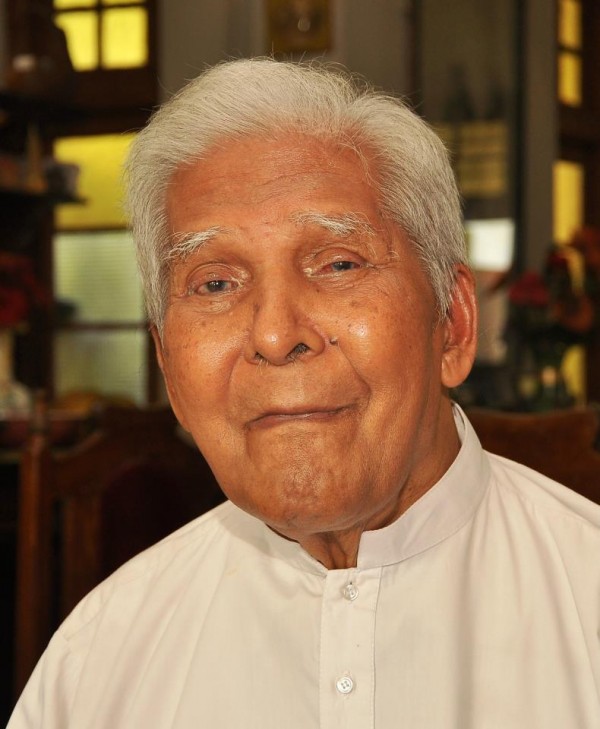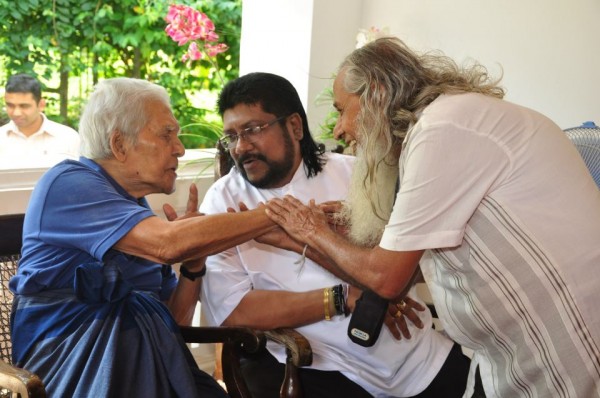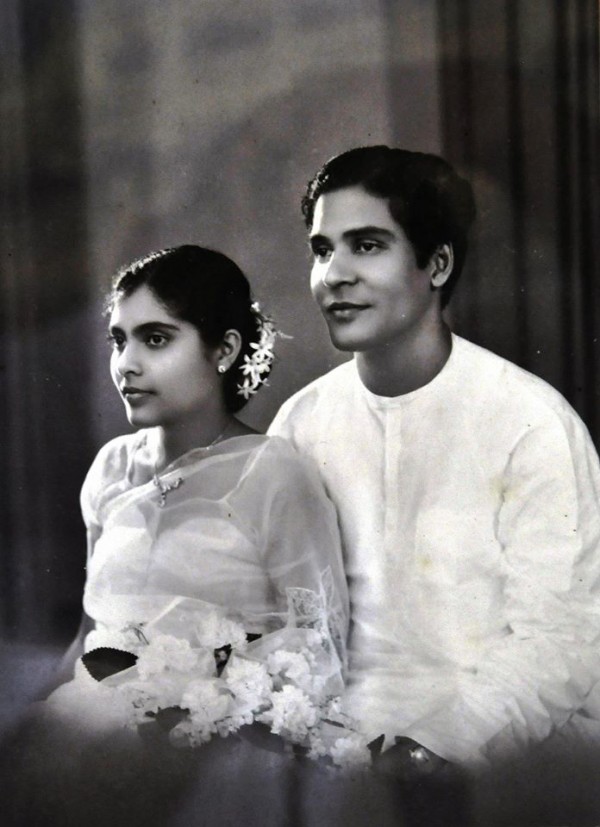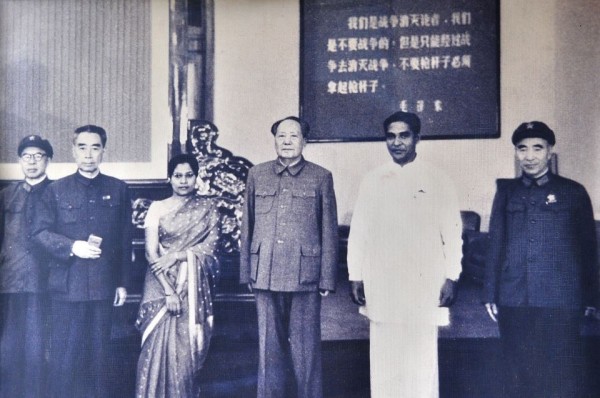Former Gampaha MP S.D. Bandaranayake the Colourful Maverick Known as “Imbulgoda Veeraya” Passes Away at 97 Years of Age
SD Bandaranayake, one of Sri Lanka’s colourful Political personalities passed away on June 3rd 2014 at the ripe old age of 97. The funeral of the man who represented the Gampaha constituency for thirty years in Parliament will be conducted on Saturday June 7th at the Chandrajothi school grounds in Yakkala.The laird of “Madugas Walawwa” in Yakkala was a vibrant Politician who shot to fame in 1957 for stopping the JR Jayewardena led march to Kandy at a place called Imbulgoda along the Colombo-Kandy road.SD Bandaranayake was dubbed the “Imbulgoda Veeraya”or hero of Imbulgoda after the incident.

SD Bandaranayake
When I heard of SD Bandaranayake’s death I was shocked because I had been under the impression that the hero of Imbulgoda had died some years ago.Had I known that SD Bandaranayake was alive I would have definitely tried to visit him when I was in Sri Lanka last year after 25 years of absence from the land of my birth. It was only after his death that I came to know that SD had been ailing for some time and had died peacefully at a private hospital.
The maverick SD Bandaranayake is one of the Sri Lankan politicians for whom I have had lots of admiration and affection notwithstanding the fact that he has been described by some as an “unguided missile”.This non –conformist streak of independence and his progressive outlook on Sinhala-Tamil relations endeared the man to me.I have been fortunate in interacting with him personally a few times in the past and listening to his various experiences and anecdotes.It is against that backdrop that I write here about the life and times of Samuel Dias Bandaranayake.
Many of the younger people in Sri Lanka may have never heard of SD Bandaranayake or of his colourful political past. The Imbulgoda incident which made him a hero more than fifty years ago is now forgotten. So too is the fact of his incarceration after the JVP insurgency of 1971 and being charged as the 25th accused along with Rohana Wijeweera and others.Very few would remember that the founder leader of the short lived Bosath Bandaranaike Peramuna had a long lease of life as Gampaha MP from 1952 to 1970 and 1977 to 1989.

SD Bandaranayake’s son Pandu Dias Bandaranayake-in the centre in this picture of March 2013
In the present context it may be easier to introduce SD Bandaranayake as the father of national list MP , Chakrawarthi Pandukabhaya Dias Bandaranayake the deputy minister of indigenous medicine. Incidently Pandu Dias Bandaranayake has suffered two bereavements in the past week.His father in law Terance Gunawardana the former Air Force chief too passed away last week.
MAVERICK POLITICIANS
The Sri lankan political firmament has been illuminated from time to time by fiercely independent and politically unpredictable parliamentarians.Apart from SD Bandaranayake others like ”Banis Maamaa” Dr.Wijayananda Dayanayake , “Podi Putha”Mudiyanse Tennekoon,KMP Rajaratne,Vasudeva Nanayakkara, Sir Razeek Fareed,”Adangaath Thamizhan”Prof. C. Suntharalingam,Saumiyamoorthy Thondaman,RG Senanayake,Lakshman Rajapaksa, Prins Gunasekara, M.S. Kariyapper and M.M. Mustapha have made their marks as mavericks in the political sky.In my opinion the greatest Maverick of them all in post-independence Ceylon/Sri Lanka was Dahanayake. I would place SD Bandaranayake as a close second.It must be noted however that the political life of SD has been closely inter-twined with some of the significant events in Sri Lanka’s contemporary history.
Samuel Dias Bandaranayake known widely as SD or SD Bandaranayake was born on December 1st 1917.SD belonged to the feudal upper classes and was connected to the extended Bandaranayake clan. Though SD dabbled in politics he never enjoyed high political office like his kinsmen SWRD or Felix R. Dias Bandaranaike.SD’s branch of the family remained more faithful to their roots and did not embrace Christianity or “Anglicisation” like the Horagolla aristocracy. Their names too were spelled differently in English. While SWRD was a “Bandaranaike” with an “I”, his cousin SD was a “Bandaranayake” with a “YA”.

SD’s father was Mahamudaliyar CP Dias Bandaranayake of Gampaha while his mother was the daughter of Mahamudaliyar Ekanayake of Matara.Mahamudaliyar CP Dias Bandaranayake was among the prominent Sinhalese incarcerated by the British after the 1915 Sinhala-Muslim violence.SD studied at St. Thomas’College Mt.Lavinia and St.Thomas’College Matara.He was apparently good in studies and sports and was both a scout and cadet.
SD enrolled at the newly established University of Travancore in what is Kerala state today in India. He pursued a course in Agricultural studies. During his undergraduate days SD was impressed by the Indian freedom struggle.He also imbibed communist ideals from Malayalee Marxists.SD Bandaranayake’s hero in the Indian freedom struggle was neither Mahatma Gandhi nor Jawarhalal Nehru but Subhash Chandrabose known as “Netaji”.SD named his eldest son Subash in honour of Netaji.
SUBASH CHANDRABOSE
Subhash Chandrabose in 1939 broke ranks with the Indian national congress and formed the “Forward Bloc” that advocated an armed military revolt against the British instead of non –violent “Satyagraha”protests. SD Bandaranayake travelled up to Calcutta (Kolkata now) in 1940 and met Chandrabose personally.He also visited the “Shanti Niketan”and met Rabindranath Tagore. Another great son of Bharat whom SD met in India was “Aachaarya” Vinoba Bhave who started the “Bhoodan”movement in 1951. Influenced by the Bhoodan movement, SD was in later life to voluntarily donate much of his ancestral property to landless people.
The second world war was in progress when SD returned to Sri Lanka. Sri Lanka’s first Prime minister DS Senanayake was then serving as minister of Food, Lands and Agricuture in the State Council board of ministers set up under the Donoughmore Constitution.DS established the Ceylon Agricultural Corps to boost food production. SD joined the Agricultural corps popularly referred to as the “land army” as a commandant. He was stationed at the Ceylon Agricultural corps(CAC)headquarters in Polonnaruwa district.
SD quit the CAC after the war ended and returned to Yakkala where he engaged in social service. He also organized activities for youths.SD also joined the Sinhala Maha Sabha pioneered by his kinsman SWRD Bandaranaike and became an area organizer. Then came the Parliamentary polls of 1947 under the Dominion constitution.
SD entered active politics as an election worker for two illustrious leaders of the day. One was DS Senanayake contesting in Mirigama. The other was SWRD Bandaranaike contesting Attanagalle. Leftist leaders Edmund Samarakkody and Chandra Gunasekara challenged them at Mirigama and Attanagalle respectively. SD worked hard and diligently for DS and SWRD who were both contesting as UNP candidates. Both won handsomely.DS became Prime minister and SWRD the minister of local government and health in Independent Ceylon.
Rumblings of political discontent within UNP ranks resulted in SWRD Bandaranaike splitting from the party and forming his own Sri Lanka Freedom Party(SLFP).SD Bandaranayake threw in his lot with SWRD and became a founding member of the new party.He was one of those present at the historic inauguration of the Sri Lanka Freedom Party at the Colombo town hall on 2nd October 1951.
GAMPAHA
With the sudden death of DS his son Dudley became premier and in a surprise move called for fresh elections.SD contested in his home turf Gampaha and polled 19,417 votes. He won with a majority of 871 over BL Seneviratne of the UNP. SD was one of nine MP’s returned to parliament from the fledgling SLFP at the 1952 elections. The UNP with a sweeping victory formed the Govt under Dudley Senanayake. SWRD became opposition leader.SD Bandaranayake was placed in charge of the party youth league.
SD Bandaranayake delivered his maiden speech in Parliament in his mother tongue although he was fluent in English. Those were the days when it was considered to be infra dig for the representatives of the people to speak in Sinhala or Tamil. SD Bandaranayake spoke for 150 minutes analysing the pathetic plight of the Sinhala and Tamil medium educated or those educated in “Swabasha” in Independent Ceylon.He compared the different salary scales and pointed out how the remuneration paid to so called “English educated” was far in excess of what the Sinhala and Tamil educated were getting.
As SD Bandaranayake was about to conclude his maiden address it was suggested from the chair that he speak in English also for the benefit of the house. SD brought the house down when he demurred saying that his speaking in English would benefit only Singleton –Salmon and no one else. (R.Singleton –Salmon OBE was an appointed MP of British origin) SD however observed that he regretted not being able to speak in Tamil and said that he would be pleased if possible to speak in Tamil also in the future.

SD Bandaranaike with Chairman Mao Ze Dong
Meanwhile a rising red star was shining over China. The ascendancy of Mao Ze Dong in the peoples republic of China was capturing worldwide attention. Idealistic youths were attracted to the magnetic Mao. SD was one such youth. Though not a member of the communist party in Sri Lanka the left leaning SD Bandaranayake became interested and involved with Chinese affairs. He began subscribing to the “Peking (Beijing) Review” and began cultivating links with China and her people.
DIFFICULT SITUATION
In 1952 the country faced a very difficult situation economically. The Korean war boom was over and the west particularly the US had reduced purchase of commodities from the Island.The export prices of tea, natural rubber and coconut oil dropped by 10%,36% and 40% respectively. Overall export earnings diminished by 23% in a year. A trade deficit of 200 million rupees occurred.
Independent Ceylon faced a crisis as there was inadequate rice production to feed the population on the one hand while there were no buyers for exports particularly natural rubber.The US was approached for a $50 million loan which was not granted. It was at this desperate juncture that SD Bandaranayake’s Chinese connection helped in him being of service to his country in a small way.
China was having a problem of its own due to shortage of rubber. A UN resolution had prohibited the export of Rubber to China from what was then the federated states of Malaya under British rule. According to SD Bandaranayake he became aware of China’s predicament and had suggested to then Trade and commerce minister Richard Gotabhaya Senanayake that we could explore trading our rubber for rice from China. SD had also sounded out China through unofficial channels and found Peking to be amenable in principle.
RG Senanayake a first cousin of Prime minister and an unconventional politician was favourable to the idea. He pursued the idea assiduously with the backing of Dudley. The move was strenuously opposed on ideological grounds by the US lobby led by JR Jayewardene. Both Dudley and RG felt that ideological considerations should not stand in the way of trade that would be beneficial to the national interest.
RICE-RUBBER PACT
To the credit of the pragmatic RG Senanayake, he went ahead with the idea and negotiated the Ceylon-China Trade Agreement commonly called the Rice-Rubber Pact despite JR’s opposition. By an interesting coincidence both RG and JR had the same name Richard referred in short as Dick or Dicky.It was around this time that the press had a field day dubbing Richard. G Senanayake as “China Dicky”on account of his perceived closeness to China and J. Richard Jayewardene as “Yankee Dicky” due to his pro- US stance.

SD Bandaranaike with Dr. Samala Dias Bandaranaike, his daughter
The Rice –Rubber pact was of immense benefit to the country and though the full credit goes to RG Senanayake, the unsung role played by SD Bandaranayake also deserves mention in this regard. It was a commendable act of patriotism undertaken quietly without fanfare or publicity.Though in the opposition SD Bandaranayake thought of country above partisan party affiliations.This was a trait in SD Bandaranayake that surfaced on several occasions and landed him in trouble.
1956 elections saw SWRD Bandaranaike triumphing at the polls with a thumping majority and forming a people’s government fondly described as “Apey Aanduwa” or our govt.SD Bandaranayake polling 34,898 votes won with a huge majority of 29,802.After the sweeping victory, SWRD Bandaranaike summoned his kinsman SD Bandaranayake to ask him which portfolio he would like in the government in formation. To his surprise SWRD found himself facing two requests from SD. The first was was that SWRD should invite all the parties in opposition and together form an all party national govt. The second request was that the administrative apparatus be radically transformed by inducting persons educated in the Sinhala and Tamil languages into government service in large numbers.
Prime minister turned down SD Bandaranayake’s twin requests saying one was impossible and the other not possible immediately.SD then asked SWRD whether he would prioritise his two requests in the near future. This too was out of the question was the reply. So SD Bandaranayake then took his leave saying that he would not accept any office in the new govt as his two requests had been refused. SWRD was flabbergasted by SD declining office at a time when others were pressuring him for a portfolio. Such was SD Bandaranayake’s caliber.
UNGUIDED MISSILE
It was after this incident that SWRD referred to SD affectionately as an unguided missile. Recognizing however SD Bandaranayake’s political acumen and abilities the honourable member for Gampaha was made the party general-secretary, its youth wing chief and trade union coordinator.Having declined ministerial office SD Bandaranayake was busy serving the people of Gampaha and his party the SLFP when a fresh crisis brewed.

S.D.Bandaranaike with Sirimavo Bandaranaike and D.A. Rajapaksha
The act of making Sinhala the sole official language in 1956 had brought in its wake a language conflict. The Tamils of Sri Lanka and substantial sections of Tamil speaking Muslims opposed it and demanded parity of status for both Sinhala and Tamil. Communal violence erupted. In a bid to resolve the situation ,Prime minister Bandaranaike held talks with the dominant Tamil party known in Tamil as the Ilankai Thamil Arasu Katchi (ITAK) in Tamil and Federal Party (FP) in English. After discussions an agreement was reached in 1957 where regional councils providing a degree of autonomy were to be set up. The accord was signed by Prime minister Bandaranaike and the FP leader SJV Chelvanayagam. It was referred to widely as the Banda-Chelva pact or the B-C pact.
Opposition to the B-C pact was whipped up and orchestrated by hawkish elements in the majority community. The chief opposition UNP down in the doldrums after the electoral debacle of 1956 also hopped on to the bandwagon and launched a protest campaign against the Banda – Chelva pact saying the Sinhala language and Buddhist religion were in danger. Since Dudley Senanayake had quit active politics after 1953 and former Prime minister Sir John Kotelawela was in virtual retiremet it was former finance minister Junius Richard Jayewardene who was now the de facto leader of the UNP.
The UNP decided to march to Kandy and take an oath at the Dalada Maligawa that they would safeguard the country by opposing the B-C pact. The UNP wanted to make a grand spectacle of it by marching through the densely populated areas along the Colombo-Kandy Road in stages and covering the distance of 72 miles . A public meeting was scheduled at the ‘Pattiruppuwa’ at the end of the march.
KANDY MARCH
The Mahanayakes of Asgiriya and Malwatte Chapters were persuaded to extend an open letter of invitation requesting people to assemble in Kandy on October 8 1957 and take a vow before the Sacred Tooth Relic that they would prevent division of the country through the agreement between Bandaranaike and Chelvanayagam. October 8 was a full-moon Poya Day. JR’s plan was to start a six day march on October 3 and reach Kandy well in time for the mass rally on October 8. The marchers, describing themselves as pilgrims, were required to walk 12 miles each day.
Thousands of UNP stalwarts and supporters including J.R. Jayewardene, M.D. Banda, Anandatissa de Alwis, Dr. MVP Peiris and Ranasinghe Premadasa began the march from Colombo on October 3. Violence was unleashed in the form of stones being thrown and marchers being beaten. The stoning was intense in areas like Grand Pass and Peliyagoda. The police did nothing as they had been instructed not to intervene. Mobs of government supporters gathered along the route and began hooting and jeering.
Several traffic jams were caused by the march. Many turned back due to the violence. The marchers walked 12 miles and reached Kadawatha to rest for the night. Once again, government-backed mobs began to stone the houses in which UNP marchers were staying in Kadawatha. Again the police did nothing.

with former President Chandrika Kumaratunga
JR hoped to end the second leg of the trek at a Buddhist Vihare in the Attanagalle electorate. Attanagalle then was the pocket borough of the Bandaranaikes. Allowing JR to march in and tarry for the night was seen as a political challenge and personal affront. Prime minister SWRD Bandaranaike summoned the person whom he had described as an unguided missile. Gampaha MP and kinsman of S.W.R.D., S.D. Bandaranaike was assigned the task of stopping the march before it reached Attanagalle. The unguided missile was now given a definite “target and coordinates”.
SD Bandaranayake planned a strike that was intended to shock and awe. Anticipating that the marchers would reach a particular spot in Imbulgoda along the Colombo-Kandy road in the morning “El commandante” SD mapped out his strategy. There was a particular spot on the road that was very conducive for a “guerilla” attack. The road was narrower and had embankments or small hillocks on either side around a short bend. It was an ideal place to launch an attack as the assailants would have had a field day pelting stones down.
IMBULGODA
The UNP resumed the march at the crack of dawn.Three miles of marching saw the UNP reach Imbulgoda at about 7:20 a.m. At one point the marchers saw two vehicles parked in the middle of the road. A man was lying on the road between both vehicles. The horizontal obstacle was none other than Gampaha MP, S.D. Bandaranayake. About 150 people were sitting on the road behind the vehicles. More than 500 persons were standing on either side of the road with objects to be thrown at the marchers. One of the vehicles on the road was the volkswagon bearing the number 1 Sri 1901 which belonged to SD Bandaranayake. The people of Gampaha had presented it to him earlier. The other vehicle was owned by SD’s political associate Dr. MC Chandrasena who was standing behind it.
According to SD Bandaranayake he had brought only twelve men including Dr. Chandrasena and himself for the operation. He had stationed five men each on either side of the road. They were armed with “Thambili Koamba”(young coconuts devoid of sweet water and kernel) and had no stones, he was to say later. The people of the area had begun to gather on the spot on their own when they heard of what was happening. The crowds had spontaneously increased to more than six hundred was SD Bandaranayake’s version of the incident.
When the UNP procession reached the spot SD’s storm troopers began throwing the young coconuts and then stones at the marching persons. The group scattered and some sought refuge in nearby homes and boutiques.

Former Police Assistant Superintendent D.S. Thambaiyah was in charge of security in that area. Even as the stone throwing began, he intervened and asked JR and the marchers to stop a while. He then began talking to S.D. Bandaranayake, urging him to remove his supporters.SD replied by saying that he had not brought anyone to stop the march and that he was only protesting non-violently to prevent the march as it was likely to disturb peace and trigger off violence if allowed to proceed unchecked.
STAND-OFF
The ASP then informed his superiors of the stand-off and placed a police party in between both groups as a buffer. He also warned the bystanders not to pelt stones. The mobs then ended their stoning but threw paper balls, trash, and sand at the dwindling number of marchers. Soon Police DIGs “Jungle” Dissanayake and Sidney de Zoysa arrived with a posse of armed policemen. After palavering with both parties, the senior DIGs asked JR to call off the march as a major breach of peace was anticipated.
JR was aware that his followers were deserting him and agreed to call it off. But he told the DIGs that he intended walking alone as a pilgrim to Kandy. A solitary pilgrim could not disrupt peace, JR pointed out.Dissanayake and de Zoysa then asked for time to consult higher authorities about JR’s request. JR meanwhile squatted by the side of the road and told his supporters that he would continue his march and in an exhibition of ‘Gallery Sellama,’ said that he had written his will before starting out. JR requested his supporters to go back. However, predictably, the UNP supporters would not accept JR’s stance and urged that all of them retreat with honour.
Subsequently JR was told that the march was totally banned and no individual would be allowed to proceed on foot. So JR called off the march officially. S.D. Bandaranayake too was informed that the march was officially banned. SD then made a rousing speech to his supporters and got them to disperse quietly by 10:30 a.m.
Four buses of the Ceylon Omnibus Company were called and the remaining 70-75 UNP members including JR got in and started out for Colombo at about 12:30 p.m.. Police escort was provided. Thus ended the infamous Kandy March led by JR. Jayewardene.The UNP could not enter Attanagalle s intended thanks to SD.
Thereafter S.D. Bandaranayake was described on political platforms as the ‘Imbulgoda Veeraya’ or ‘Hero of Imbulgoda.’ SD himself called it a people’s victory and said that he had initially blocked the march with only 12 people and that gradually hundreds of people had flocked in support voluntarily. This then is the story of how SD Bandaranayake became known to an earlier generation as the Imbulgoda veeraya.
To Be Continued
http://www.dailymirror.lk/opinion/dbsjeyaraj-column/48124-imbulgoda-veeraya-with-us-no-more.html
Source : http://dbsjeyaraj.com/dbsj/archives/30424


No comments:
Post a Comment